
"Ars longa, vita brevis"

Netzach Gallery presents. . .
PSYCHOGENESIS I
ALCHEMICAL REALITY

THE SOURCERESS: FIRE & ICE
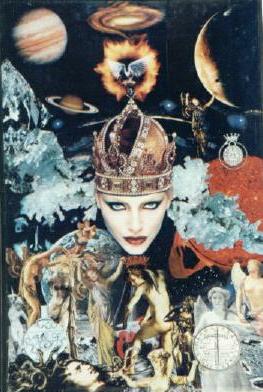
The High Priestess, mistress of our guided tour to the Abyss of the Transcendent
Imagination, gazes out serenely from her inner kingdom. The image
is actually one of many incarnations of Psyche, whose name in Greek means
butterfly, and is a universal symbol of the soul. This Psyche is
in rapport with Spirit, as symbolized by the dove enclosed in the circle
of flame over her crown. It reflects the mythography of Psyche &
Eros, the divine couple. There is alchemy and magick here in this
world, where serpents are a healing force. Myth tells us that the
blood of Medusa, the serpent-haired one, was a potion—that from the right
side a healing balm, that of the left a fatal poison.
As the Soul of the World, the Anima Mundi represents a way of affirmation
and fullness. She is the plenum, the panoply or pandaemonium of psychic
imagery—our Hostess for the inner journey we are about to embark upon.
She is a soul-guide, a mediatrix of consciousness between the personal
and collective. She balances the actualities of daily life with the
demands of the Beyond. Ego consciousness emerges as the result of
her prior psychic life. The creative process emerges from the unconscious
by the “way of the Mothers”—rebirth.
The alchemist’s conviction that psyche and its fantasies are as real as
matter depends on how convincing anima makes herself to us.
Internalization is necessary for psychic consciousness. It means
being aware of your fantasies and recognizing them everywhere, including
your belief system. Your fantasies are not separate from your reality,
but are instrumental in forming your experience of it.
Personifying is a characteristic effect of the anima archetype.
The embodiment of libido can only be apprehended in definite form.
Your rebirth is identical with your rebirth images, emotions, actions,
and feelings. This angel’s individuation into a distinct personality
is precisely what soul-making is all about. Let your imagination
refresh your intellect with fantasy.
Behind Eros, the alembic, or alchemical vessel of transmutation,
contains the symbols of the three stages of the work (body, soul, and spirit;
mercury, sulphur, and salt) as black, white and red birds. When united
they produce the Philosopher’s Stone, Elixer, or Panacea: the universal
remedy of cosmic consciousness.

POSTMODERN BAPHOMET
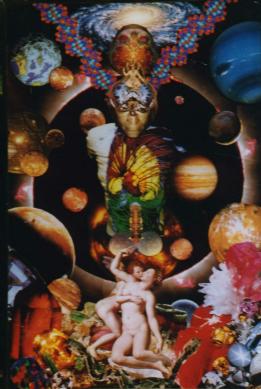
The alchemists concretized or personfied practically all their most important
ideas—the four elements, the vessel, the stone, the prima materia,
the tincture, etc. The idea of man as microcosm, representing in
all his parts the earth or the universe, is a remnant of an original psychic
identity, which reflected a twilight state of consciousness, according
to Jung. This primordial man has taken many forms throughout history,
such as Adam Kadmon in Qabala and Purusha in Indian philosophy. In
Tarot, this companion of the High Priestess is the Magus,
or Magician.
In 1307, the Knights Templar were accused of worshipping the heretical
figure of Baphomet, considered by the uninitiated as a symbol of Satan.
In reality, this symbol comes from a level deeper than and prior to such
dichotomization as good/evil where the opposites are still fused.
It is actually a symbol of fertility, the erotic element being symbolic
rather than literal.
The name itself is a puzzle, perhaps the corruption of Mahomet, brought
back to Europe during the Crusades. He figured priminently in the
Cathar heresies, and provided the basis for accusations of heresy and witchcraft.
However, the name probably comes from combining two Greek words—baphe
and metis—and means “absorption into wisdom.”
19th century magician Eliphas Levi’s version of the figure nestles in the
opened cranium of this Post-Modern Baphomet, and helps provide an alternative
image of the Tarot Trump, The Devil. On his arms are the alchemical
terms solve and coagula, reminding us that to create the Philosopher’s
Stone we must dissolve ourselves in chaos and then re-emerge with a reborn
embodiment.
Levi called the figure ‘a pantheistic and magical form of absolute,’
a diagram of the god who is the sum total of everything in the universe—an
obviously phallic principle of organic life. It contains the symbols
of the four elements: the head stands for fire, the wings for air, the
scales for water, and legs for earth. The torch is a symbol of divine
revelation, the pentagram of human intelligence, the cadeusus the union
of the sexes, etc. It is a sign of redemption.

PRIMA MATERIA EST ULTIMA MATERIA
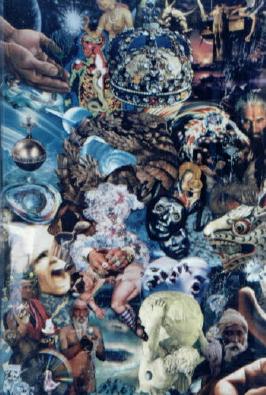
The alchemist dreams in his own specific language, which is exceedingly
obscure. In order to understand it, Jung suggests we learn the psychological
secrets of alchemy, since only he who knows the secret of the stone understand
their words. This virtually incomprehensible “nonsense” has fascinated
the most erudite minds, such as Newton, Paracelsus, Goethe,and Jung for
two thousand years. The symbolism of alchemy has to do with the structure
of the unconscious, and modern dreams contain the same metaphors.
Its practical value should not be underestimated.
The alchemical operation consists essentially in separating the prima
materia, the so-called chaos, into the active principle, the soul,
and the passive principle, the body. They are then reunited in personified
form in the coniunctio, the ritual combination of sol and Luna,
which yields the magical child (filius sapientiae or filius philosophorum),
the reborn self, known as the ultima materia. The collective
unconscious appears in the many symbols of religion, myth, art, and dreams.
The Uroborous dragon biting its own tail depicts the original chaotic condition,
which prevails before the radical transmutation. But it contains
all the refined ingredients of the ultimate state in their uncooked form—the
heat has yet to be applied to the unrefined material, raw uncooked emotion.
Therefore, we see not only the anguish and despair of the beginning, but
the seeds of rejuvination, rebirth and promised illumination of the final
stages of the process. Thus, prima materia is the seed of
the process, which takes place in the natural mind; it is the seed of enlightenment.
The Crown of Creation is an overarching symbol equating with the top sphere
Kether in Qabala. It triumphs over the terrible Dragon of the primal,
unrefined condition, represented by the dragon or Terrible Mother.
In the bottom-center is Atlas holding the earth to symbolize the material
sphere of Malkuth. All is one magical movement from Kether through
Malkuth. Ego cannot separate itself from the powers and abilities
of the subconscious. To submit this material to the process means
to apply conscious effort to the task, and find our own experiential spirituality.
Prima Materia represents the crossroads or crisis preceding a spiritual
awakening (intellectual doubts, metaphysical problems).

EGO DEATH: BLACK SUN/THE RAVEN’S HEAD
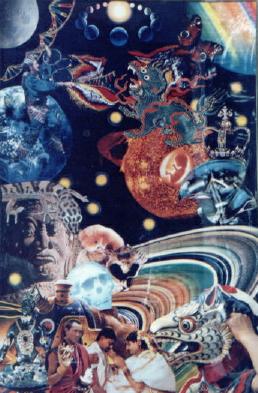
“The principle of the art is the raven, who flies without wings on
the blackness of the night and the brightness of the day.” . . .”The dragon
shuns the light of the sun, and our dead son shall live. The king
comes forth from the fire and rejoices in the marriage.”
Jung, Mysterium Coniunctionis
Alchemists called the blackness of the initial depression, grief or stuckness,
the Raven’s Head or Black Sun, nigredo, melancholia = Saturn/Earth.
Rings of Saturn. The sun is surrounded by the anima media natura
and is therefore black. It is a state of incubation or pregnancy,
foretelling rebirth from the living death of repression, aridity, or inability
to work. Here is the juxtaposition of Sun and
Sol-Niger, the
anti-sun.
Life as ego has known it in the past is outmoded—the old self-image must
die. This precedes psychological revolution and creative reorganization.
The black substance of our own shadow must be met and reconciled.
Mourning the death of the old self. Emotional participation unblocks
the flow of psychic energy and sense of meaning.
The birth of the healing power from the Nigredo belongs to the archetype
of the wounded healer. It reflects the psychological capacity as
stated by Kerenyi, “to be at home in the darkness of suffering and there
to find the germs of recovery with which as though by enchantment, to bring
forth Asklepios, the sunlike healer.” This healer’s mother name
Coronis means “crow maiden”. The bird of Hermes is also the Raven.
The caput mortuum (death or death head) or raven head is the head
of the black Osiris or Ethiopian and also of the “Moon” in the Chymical
Wedding. The skull is the vessel of this alchemical transformation.
Prior to the change in self-image, one lives a living death, identified
only with the vacuousness of the ego’s relative position—a suffering of
spiritual poverty.
I, The Juggler or The Magician does his balancing act between the Sun and
the Moon, the personified opposites. 0 and XXI The World, Daath octave,
Babe in the Abyss, Nihilism. The Nigredo is called “black,
blacker than black,” an existential stuckness, the empty void. But
by cooking this raw state, a lighter, enlightened condition can emerge.
In Northwest native lore, Raven carried his ball of light into the sky,
so we no longer live in darkness.
In the alchemical stage known as Putrefactio, we keep up a continual
fire and regulate its action so that the Materia Universalis is
purified, regenerated and perfected within one vessel and furnace.
Nature herself does the work by means of her own inward Fire; but the later
is stimulated by the Philosophical Fire. No other work is required
from the Alchemist, to perform, but to keep up the Fire by aspiration and
prayer.

IGNIS PHILOSOPHORUM: CONCEPTUAL CALCINATIO
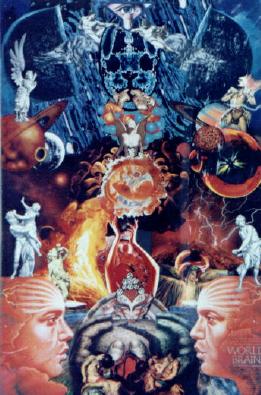
Give birth to your children while you are in the Fire; Feed, water,
and nourish them in the Fire; They will then live and die in the
Fire; They will be Fire and remain the Fire. …The Philosopher’s
Stone weeps Water; But the world does not know or esteem that Water;
The Fire of the wise burns in Water; And lives in the Water;
Turn the Fire into Water.
From, the 1st – 18th century AD, alchemy was chiefly concerned with the
miraculous water, aqua divina or permanens, which was extracted
from the lapis, or prima materia through the torment of the
fire. The water stands for the anima mundi imprisoned in matter.
This anima is set free not only by means of the “cooking,” but also by
the sword dividing the “egg,” or by the separatio, or by dissolution
into the four elements or “roots.” Divine water equates with the
power of transmutation. It transforms the nigredo into the
albedo through miraculous “washing,” animates inert matter and makes
the dead rise again.
The Rubedo, or operation of reddening, represents the salamander
coming from the refining fire. Fire equals life force responsible
for growth and germination in nature. This is the operation of Fire,
and means the transmutation of the instrument for testing purity.
Fire symbolizes libido or psychic energy. It may come from sexuality,
though ethereal fire equates with Divine Logos. This stage is the
expansion of consciousness after a crisis in development.
In the uppermost portion, the rock of the Philosopher’s Stone opens to
reveal the Holy Ghost—the ultima materia. Lead turns to Gold,
which flows forth from the winged Holy Spirit’s mouth as “Truth”.
The magickal child cooks in the heat of the rubedo, furthering its
incubation, which rests on the four quarters of the earth. The angel
protects, and oversees the process of transmutation. Elusive anima peeks
out from behind the “crack in the cosmic egg.”
Our development is fostered by the frustration of our sensual and power
drives, but only if we have a viable channel of communication with our
higher Self. This frustration is the initiatory ordeal of this phase
leading to judgement. Fire helps purge the desires to use psychic
energy for personal pleasure or power. Experience is penetrating
divine inspiration. Fire is the bath of immortality. It means
making a connection between ego and transpersonal psyche, learning to see
the archetypal aspect of existence. Fire takes on the transforming
aspects of Holy Spirit, rather than merely bringing a consuming fire reflecting
the pain of a frustrated ego.

THE ALCHEMICAL HOMUNCULUS
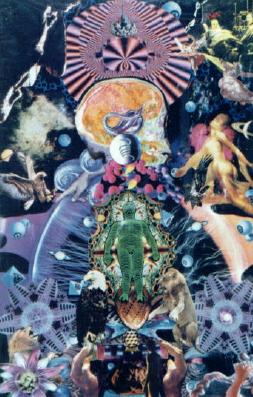
The symbolism of the starry heaven coincides with the motif of polyopthalmia
(many eyes). The dragon or serpent represents the initial state of
unconsciousness, which is to be sacrificed. The inner man, the
homunculus passes through the stages and undergoes transformation.
In Zosimos, the homunculus stands for the uroborous and is synonymous
with Ion, the self-sacrificing priest of the mysteries. Uroboros
is also identified with the ego, and the division into four. As an
arcanum, the egg is a synonym for water, the dragon, and World Egg.
This image represents the charging or energizing of the Homunculus—the
emergent Rotundum. Psychologically, it is analogous to self-reparenting,
and materializing archetypal forms. Understanding appears as if it
were a “conception.” The Homunculus is the product of the Royal Marriage
of Sun and Moon, and is equivalent to the lapis or anthropos.
In the ancient art of alchemy, the soul is depicted as a homunculus or
“small man.” It is symbolically equivalent to the Elixer or Universal
Medicine. It personifies the unconscious as an inner man, a hermaphroditic
being, a spirit in a bottle, a “brain child.”
Zosimos and Paracelsus spoke of the homunculus as devouring himself, and
giving birth to himself—the death/rebirth necessary for casting off the
old and inviting in the new self image. The paradoxical image typically
appears before dissolution of the center into its unconscious element—the
undifferentiated consciousness of the ground state. In alchemy, the
homunculus is sort of a primal “test-tube baby,” created through a dynamic
process in the Hermetically-sealed retort vessel. Dr. Frankenstein
never had it so good. It feeds daily on the hidden mysteries of nature.
Psychologically, this process is the creation of renewal of spirit, which
takes place in the psyche when psychic contents are prevented from “leaking
out” and being lost. “Heating” is symbolic of amplifying or intensifying
the transformative process. In terms from chaos theory, magnetizing
the entity, an ancient prescription, might insinuate the formation of a
strange attractor as the complex core of the system. An attractor
describes a temporary stability far from equilibrium.
The homunculus is the archetype of the magical child. It is
thus an embryonic symbol of rebirth, or re-creation of self by Self.
In alchemy, the homunculus is generated by a succession of transformations
through the four elements to reach its essential nature. The elements
of fire, earth, air and water are analogous to spiritual, physical, mental
and emotional life.

ALCHEMICAL PEACOCK'S TAIL

Mercurius, or common mercury was literally quicksilver in alchemy.
Mercurius philosophicus, the arcane substance, was likened because
of its fluidity and volatility with divine water. It is the water
which does not make the hands wet, the prima materia or primeval
chaos, and the ultima materia, the philosophical man, the lapis.
It is the healing process.
Mercurius consists of all conceivable opposites, both material and spiritual.
On one hand, he represents the self and on the other the individuation
process as redeeming psychopomp or evasive trickster; God’s reflection
in physical nature.
Immediately before the albedo or rubedo all colors appear
like a peacock spreading its shimmering fan. It announces the end
of the work is at hand. The irridescence of Philosophical Mercury
emerges as the ever-mobile, shape-shifting energies of the Soul.
Psychologically it means that during the assimilation of the unconscious,
the personality passes through many transformations, which show in different
lights and are followed by ever-changing moods. These changes presage
the coming birth.
Only from this inner substance can the soul tinctures be prepared.
This stage of integration takes place in a sealed flask, cut off from the
outer environment. It requires no external heating as it now contains
in itself, a sufficient degree of heat for the process to continue.
Peacock’s Tail brings about and betokens the transformation of the poisonous
dragon into the healing medicine. The peacock is inner beauty and
the perfection of the soul.
The resolution and integration of the Three Principles of Salt, Sulphur,
and Mercury means integration of contradictory feeling-values. Mercurius
is the play of colors in the Cauda Pavonis, whose appearance heralds
the attainment of the goal – restoration of the integrity of the spirit
– transfiguration.

MAGICKAL CHILD MANDALA

"May this water, prepared for the rebirth of men, be rendered fruitful
by the secret inpouring of this divine power; may a heavenly offering,
conceived in holiness and reborn into a new creation, come forth from the
stainless womb of this divine font; and may all however distinguished by
age in time, or sex in body, be brought forth into one infancy by the motherhood
of grace."
The Missal
This mandala represents the Lapis Philosophorum Quadratus and the
operation of circulatio, cyclic circulation among the four elements,
resulting in the quintessence. The eclipse is a symbol of the marriage
of the sun and the moon, the union of opposites. The immature
ego is eclipsed and threatened with destruction when it naively embraces
the maternal unconscious. However, other images indicate that such
an eclipse can be inseminating and rejuvinating.
The ego, by incarnating takes on substantial reality, but also becomes
subject to corruption and death. The ego is eventually eclipsed,
but from its death the "child of the philosophers," the Philosopher's Stone
is born. Both sun and moon die and transfer their power to their
offspring. Even if it is caused by the wisdom of God, the blackening
or eclipse of the sun is a fearful experience, since sun and moon have
a destructive side. It is like two loving people who open their hearts
to one another and find that vulnerability, doubts and distrust increase
also. The ruling principle of the conscious ego must die and transform.
This archetypal expression of the Divine Child is a healing panacea.
When the savior child is born, all the forces of darkness attack worse
than ever before. Saying goodbye to a neurotic attitude is sad and
we resent being separated from our infantility. The divine child
naturally always escapes this last outbreak of darkness, because even though
newly born it cannot be suppressed anymore. The light is born in
darkness. The stone is therefore produced with a process compared
with childbirth. The symbolic process begins in chaos and ends with
the birth of the new personality.

SOMA SOPHIA
BODY WISDOM: THE NATURAL SENSES
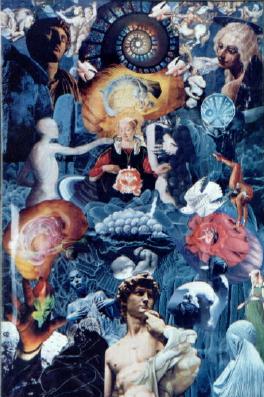
Coagulatio is the operation of turning something into earth--spirit
manifesting as substance, so it often equated with creation. When
psychic substances become earth, they take on a particular, localized form,
promoting ego development and solidifying personality, connecting the ego
with the Self. Here it is represented by the substantive reception
of physical impulses via the sensory organs, which is also the confinement
within the limits of our own personal reality, but with the capacity for
redemption. Psychic development is a process of coagulatio--the
images of dreams and active imagination coagulate, connecting outer and
inner worlds and relationships. The preexistent totality, the Self
is first incarnated, then assimilated through the living efforts of the
individual. Then spirit inhabits body.
The blue background of this piece is composed of closeups of actual sensory
apparatus, the various sensory receptors. In the center, the incubation
of the divine child continues within the realm of the anima--active imagination.
The spiritual sense, and even the symbolic sense of balance interact to
produce a quickening of the transmutive process. Images of sexual
sense, chastity, pregnancy, even dreamsex amplify the definition of the
natural senses, the basic substance of existence and embodiment, without
which consciousness cannot interact with the environment. The illuminative
brain/mind is the center of the revealed truth of a living Universe, a
process/goal of evolution, which is overseen here by the celestial hierarchy
and the Absolute.
The anima media natura corresponds to Sophia caught in the embrace
of Physis and is equated with Divine Wisdom, the feminine counterpart of
God. This gnostic Sophia is the alchemical mother. Our own
belief in the light means the spirit draws the soul to itself from its
imprisonment in the body.

PRIEST OF THE MYSTERIES

Again I beheld the divine and holy bowl-shaped altar, and I saw a
priest clothed in a white robe reaching to his feet, who was celebrating
these terrible mysteries, and I said "Who is this?" And the answer
came: "This is the priest of the inner sanctuaries. It is he
who changes the bodies into blood, makes the eyes clairvoyant, and raises
the dead."
The Visions of Zosimos
Socially-recognized mediators, the priests of various paths may have little
in common except their alleged ability to establish contact with gods and
spirits. Their basic function is to communicate with the divine for
the community. When priests intercede they come between the suppl;icant
and God; when they step aside, direct mystical experience of the Magus
becomes possible. In ancient times, priest and magician shared a
common arena. They functioned as medicine-men or shamans, specialists
in the supernatural. However, we also have an indwelling priest of
our own inner mysteries who can function as a personal soul-guide
One claim to priesthood comes from the spontaneous experience and expression
of transcendental powers deriving from psychological states interpreted
as the chosen of the divinity by the process of vocation. Shamans
usually begin their service with a schizophrenic breakdown which they intuitively
learn how to heal and can therefore heal others with their new knowledge.
The magician is called upon to restore disturbed relations with the supernatural
powers and set things aright. This is an art and a power available
only to the predisposed, developed through apprenticeship.
Where priests receive formal insturction, the first period of training
consists in learning religious beliefs and performing various rites, while
the second is devoted mainly to self-training in the course of which the
novice seeks mystical experiences and a direct relationship with divine
powers. The social position of priests may inspire awe of these mouthpieces
of the gods, and often provides them with privileges.

THE GREAT GODDESS
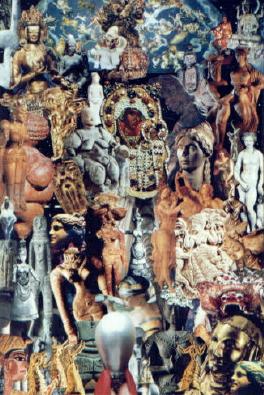
Worship of the Great Goddess through the aeons represents reverence for
the Divine Feminine from the Paleolithic times to the Present. Her
continued worship through time is shown by the myths, shrines, and sanctuaries
around the world that honor this powerful symbol of creation. The
cave was one of her original symbols. She is worshipped in Native
American, Egyptian, Indian, and Asian civilizations, and more. Although
her worship has sometimes been forced underground, it never disappeared.
In ancient Babylon she was Anat, in Egypt Isis and Hathor; Dana in Celtic
Ireland; Rhea and Demeter in Greece; and in India, Anapurna. Kwan
Yin, Aphrodite, Ishtar, Persephone, Madonna and many more names and faces,
yet all one primal Goddess. She is the symbol of Earth and the giver
of life, the Vast Mother, who represents all the powers and mysteries of
creation for early humanity.
Shifting her solar association onto masculine deities and blackening those
of her symbols that, like the serpent, could not be assimilated, patriarchal
societies forced the preeminent power of the feminine into an obscure and
subservient position. Yet, the Goddess did not simply disappear when
her position was usurped. The power she represents has been the source
of continuous religious devotion from acient times through the Middle Ages,
and up to the present day. There is abundant evidence of the extraordinary
permanence of her worship--even at the heart of those religions that tried
to destroy Her.

FERTILITY RIGHTS



EROS AND PSYCHE
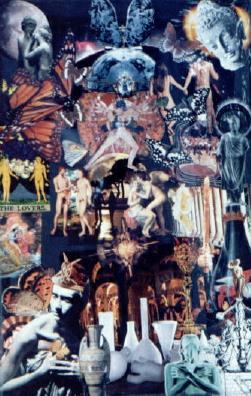
The myth of Eros and Psyche comes to us from a Greek initiate in the Eleusinian
or Isis Mysteries. It is of great psychological value, revealing
the development of an initiate's relationship with the anima. Eros,
the reproductive passion is transformed through its relationship with Psyche.
In a sacred marriage with his mother/daughter/sister, Eros repeats the
ancient Egyptian formula, Isis- Apophis-Osiris, concerning the mysteries
of rebirth and immortality.
The action of the anima/animus archetypes means we project our unconscious
ideas of the All-Woman or All-Man onto an individual in whom we seek this
idea essence. No single person can be the carrier of all the divine
attributes or qualities we might project onto them. When they fail
to realize our expectations, the process of consciousness-raising begins
if we reown our projections and seek the Self.
Eros moves from sexual objectification toward soulful love. The polarity
between sexual passions, secret feelings, and spiritual strivings exerts
a definite hold over the ego. Psyche moves through her four archetypal
tasks toward empowerment, empathy, and compassion through active introspection.
Each is compelling in a magical, magnetic way. The ego cannot detach
itself from either of them in our reality since each belongs to this inner
reality. We can break free and withdraw projections from both instinctual
draws and find mature, soulful love.
Passionate involvement in life unites our spiritual and emotional lives.
Facing our fears and pains--becoming conscious of our conflicts--we can
find peace. New realizations appear in their embryonic stage as conflicts
which offer us choices in life. These decision points become either
our life's path or roads-not-taken. Eros, like Fate, is symbolic
of the fatal power of attraction which brings opposites together.
He is the incarnating life principle, which ushers in the irrational, passionate
intensity which makes transformation possible. He "turns up the heat"
on the psychic process. He is that spiritual or divine fire which
can unite with instinct.

THE MAGUS: THE BABE IN THE ABYSS

Penetration into the Abyss of the Transcendent Imagination carries its
own perils. It is not without trouble that we storm heaven's gates,
that infinite abyss of the mysteries. There are pathologies at every
level of reality. It is the attempt to penetrate to the nondual state
of the condition that is beyond forms. Hence its ritual is that of
the "bornless one." Magician, Aleister Crowley attempted to reach
this initiation. In his magical efforts he had a Faustian encounter
with egotism and psycholoigcal danger--ending his life as an addict and
setting himself up as a false god, choking with guilt over his arrogance.
There are psychic dangers in magic even for the adept. His cult of
personality still survives, but his legacy is dubious, and often seems
pre-rational rather than trans-rational.
The critical point is that collective is not necessarily transpersonal.
Most of the Jungian archetypes are simply archaic images lying in the magic
and mythic structures of our being. They exert a pre-rational pull,
but there is nothing mystical, or transpersonal about them. It is
imnportant to come to terms with these archetypes, to differentiate them
and integrate them (transcend and include), but they are not themselves
the source of a transpersonal or genuinely spiritual awareness -- including
the so-called Holy Guardian Angel, the magical symbol of higher Self or
the Neshamah. In fact, for the most part, they are regressive pulls
in awareness and inhibit higher development. They need to be overcome,
not merely embraced as so-called divine immanence.
Just because something is collective or non-rational does not mean it is
transpersonal. Magic and myth are collective prepersonal (magic and
mythic) structures. There are also collective personal structures
(rational and existential), and collective transpersonal structures (psychic
and subtle). Collective simply means that the structure is universally
present.
Gods and goddesses are not transpersonal modes of awareness, or genuinely
mystical luminosities, but simply a collection of typical, everyday self-images
and self-roles available to us. They are self-concepts and self-roles.
To go beyond into formlessness is therefore characterized as the bornless
babe of the abyss. Transpersonal archetypes are anemic compared to
that transpersonal domain of meditative Light and Sound, the foundation
of the world...God within.

UNIO MENTALIS: SOLIFICATIO
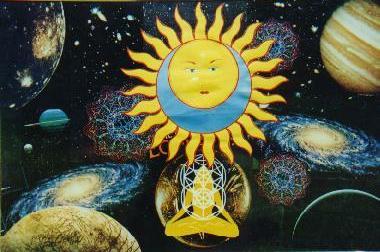
The Sun of the One I love has risen in the night,
Resplendent, and there will be no more sunset...
I saw my Lord with the eye of the heart, and I said
"Who are you?" and he said, "Your Self."
Hallaj, the mystic
One may become utterly silent inside, in a gap between thoughts, completely
perception-free of mental or sensory conteent, yet awake and fully conscious.
Therefore, this pure consciousness event (PCE) may be defined as wakeful
but contentless (nonintentional) consciousness. Advanced mystical
experiences result from the combination of regular PCEs with the minimization
of the relative intensity of proprioception, emotions, and thoughts.
De-intensifying of emotional attachments (detachment) means that, over
the years, one's attention is progressively available to sense its own
quiet interior character more and more fully. It unites soul and
spirit while placing the body in a death-like state.
The experience of peace in self, expanded core interior silence, requires
the voluntary mystical death that is explicitely connected with the alchemical
unio mentalis, the first stage of the three-stage coniunctio.
Direct self-recollection leads toward the I AM experience, but requires
becoming utterly dead to the things of the world, and void of conceptions.
It is no less than the emancipation of the soul from nature--separation
from the suffering and grief that nature brings on the soul.
Unio mentalis is the interior oneness Jung called individuation...a
psychic equilibration of opposites "in the overcoming of the body," a state
of equanimity transcending the body's affectivity and instinctuality.
The unio mentalis corresponds precisely to the philsophers who make
"dying" their profession: mystics. Desires (anger, greed, lust, attachment,
vanity) are to be killed in their obsessive, projected forms for communion
with primal Being. Then one may abide in the "Fullness of Emptiness,"
awareness of consciousness itself.
In the solificatio, the operation of the sun, this transient state
becomes a permanent or semi-permanent development of that quiet empty interior
silence of original consciousness, even during activity. One maintains
a clear sense of the interior awareness, a persisting sense of an unmoving
silence at one's core, even while working and living. One has deleted
everything inside, becoming "Nothing," blank. This dualistic mystical
state (DMS) creates oceanic feelings, the experience of being expanded,
quasi-larger or more spacious than one's own body. Consciousness
is encountered as more like a field than a localized point, a field that
transcends the body and yet somehow interacts with it.
This second stage involves reuniting the spiritual position with the body,
manifesting insights. It corresponds to the Indian concept of purusha-atman,
and implies bringing the consciousness of wholeness into full-blooded reality,
that is lived out fully in everyday life.

UNUS MUNDUS: The Unitive Mystical State
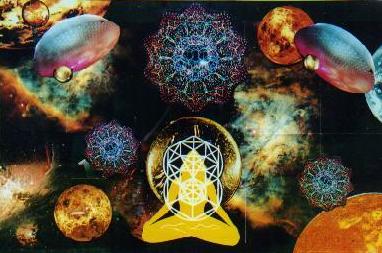
"The mystics are channels through which a little knowledge of reality
filters down into our human universe of ignorance and illusion. A
totally unmystical world would be a world totally blind and insane."
--Grey Eminence, Aldous Huxley
The mental union is not the culminating point which is experienced when
the unity of spirit, soul, and body is made one with the original unus
mundus. The primal unity of the world is experienced as the unitive
mystical state (UMS). It means first turning away from the world
of senses, then turning toward the inner world of mind and the hidden celestial
substance, the image and truth of God, and finally contemplation of the
transcendental unus mundus, the potential world outside time, the
unity of the psychic man with the cosmos.
The background of our empirical world thus appears to be a unus mundus,
analogous to the phsycial energy field or quantum vacuum field which resides
at the basis of matter and the whole of creation. They are immanent
within and also trancendent to any particular expression. Unity with
all that can be expressed as the realm of WE ARE; the ground of being,
the field of awareness may be common to all. The object perceived
and the perceiving soul are no longer separated from one another.
This temporary vision becomes a permanent way of seeing and knowing.
Ther perceived expansion of the soul is experienced as permeating with
and through the objects of the world. The expanded selff seems to
be experienced as of the same metaphysical level, or of the same 'stuff'
as the world. Mystics develop this ability through meditation.
The UMS is a permanent shift in the structure of awareness and never fades
away whether one is in nature or a busy environment, or has the eyes open
or closed.
The transcendental psychological background corresponds to a "potential
world,"--the forms of empirical phenomena are inherent in it. It
is the pristine "first day of creation." The individual who has been
reconnected with the body, is now joined with the world through conscious
realization of oneness with the cosmos. The creation or realization
of the unus mundus is a transcendent condition, a superlative experience
of unity in which subject and object, inner and outer, are transcended
in the experience of a unitary reality.
The universal psychological expression of the unus mundus is the
mandala, here represented by mandalic cross-sections of sacred DNA, the
basis of all life. The most sacred text of the alchemists, the Emerald
Tablet of Hermes, is the cryptic epitome of the opus, a recipe for
the second creation of the world, the unus mundus, via the operation
of the sun, coniunctio. Then one truly experiences first-hand the
truth of "That which is above is like that which is below."
Now the Philosopher's Stone as the savior of the Macrocosm--the great world--has
been created. Time and eternity are unified.

LAPIS PHILOSOPHORUM: THE PHILOSOPHER'S
STONE
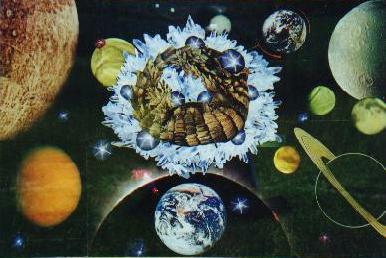
Like the Godhead, or primal creator god, Mercurius has the ability to beget
himself. He claims, "The mother bore me and is herself
begotten of me." As the uroborous dragon, he impregnates, begets,
bears, devours, and slays himself, and "himself lifts himself on high,"
as the Rosarium says, paraphrasing the mystery of God's sacrificial
death.
Urobouros is the hieroglyph of eternity. For the alchemists, the
self-devouring dragon was hermaphroditic because it begot and gave birth
to itself. They therefore called the sapphirine flower (i.e. the
lapis) "Hermaphroditi flos saphyricus." Mercurius is the uroborous,
the One and All, the union of opposites accomplished during the alchemical
process, the homunculus.
The lapis carries the double significance of prima and
ultima
materia: "Take wisdom with all thy power, for from it thou
shalt drink eternal life, until thy [stone] is congealed and thy sluggishness
depart, for thence cometh life." The lapis contains the
four elements and their quintessence can be extracted from them.
It is the panacea, universal medicine, or tincture.
In shamanism much importance is attached to crystals, which play the role
of ministering spirits. They come from the crystal throne of the
supreme being or from the vault of the sky. They show what is going
on in the world and in the sould of the sick, and give man the power to
"fly."
The uroborous is the goal of the Opus or Great Work, a symbol of a circular
self-contained, self-referential, self-organizing process--the union of
opposites and immortality.

CHAOS NATURAE
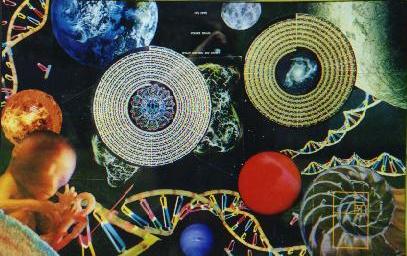
These mandalogs or numberwheels are variations on the symbol of the spiralling
serpent. The serpent is Mercurius, the fundamental substance,
which forms itself in water and swallows the nature to which he is joined.
The transcendental recursive movement (biting the tail) implies "trans-gression"
not regression. The Stone itself--or the secret of its production--is
revealed to the operator by God. Knowledge of the procedure is a
gift of God, generally through the instruction of most experienced Master.
The source of it all is the Divine Will. In Chaos, Kunrath
states that we can "perfectly prepare our Chaos Naturae (=prima
materia) in the highest simplicity and perfection" from a special Secret
Divine Vision and revelation. This divine illumination transcends
reason and only a supernatural and divine knowledge knows the exact time
for the birth of the stone. This means that God alone knows the prima
materia.
The dragon symbolizes the visionary experience of the alchemist as he works
in his laboratory and "theorizes." The dragon in itself is a monstrum--a
symbol combining the chthonic principle of the serpent and the aerial principle
of the bird. It is a variant of Mercurius, or the divine winged Hermes
manifest in matter as the god of revelation, lord of thought and sovereign
psychopomp or soul guide--the liquid metal argentum vivum, which glistens
and animates from within--the world-creating spirit concealed or imprisioned
in matter.
The dragon is probably the oldest documented pictorial symbol in alchemy.
It appears as the tail-eater in the Codex Mercurius of the tenth
or eleventh century, as the One, the All. Time and again the alchemists
reiterate that the opus proceeds from the one and leads back to the one,
that it is a sort of circle like a dragon biting its own tail. It
is therefore called circulare (circular) or rota (wheel).
Mercurius stands at the beginning and end of the work; he is the prima
materia.
As dragon he devours himself and dragon he dies, to rise again as the
lapis.
He is the play of colors in the cauda pavonis and the division into
four elements. He is the hermaphrodite that was in the beginning,
that splits into the classical brother-sister duality and is reunited in
the coniunctio, to appear once again at the end in the radiant form
of the lumen novum, the stone. He is metallic yet liquid,
matter yet spirit, cold yet fiery, poison yet healing draught--a symbol
uniting all opposites.
As Caduceus, Mercurius unities the paired opposites of mythic polarities:
creation/apocalypse; nurturance/deprivation; achievement/failure; completion/fragmentation;
affirmation/cynicism; acceptance/debilitation; hope/despair; reconciliation/polarization;
wisdom/ignorance; celebration/betrayal; rebirth/death; questing/passivity;
intimacy/separation. The issues are love, redemption, identity and
acceptance--teleology rather than reductionism. A similar idea appears
in Kundalini yoga: all higher levels of consciousness exist in us as unrealized
potential, which lies coiled up like a serpent.
Maslow found that people who were persistent self-actualizers were prone
to peak experiences--akin to mystical awareness, the 'oceanic feeling,'
a sense of fuller vision extending to apparently limitless horizons.
Maslow's description of peak experiences are like acute, episodic experience
of Atman-consciousness: there is loss of identity with the purely personal
ego and its replacement by a sense of general identity with everything
that exists, that will ever exist, and has ever existed. In this
way we become 'what we are capable of becoming.'
True alchemy was never a business or career, but a genuine opus to be achieved
by quiet, self-sacrificing work. Each individual tries to express
his own particular experiences, quoting the dicta of masters only when
they seemed to offer analogies. All agreed their art was sacred and
divine and only completed with the help and grace of God. This science
of theirs is given only to the few, and none understnds it unless God or
a master has opened his understanding. The material of the
materia
lapidis may be found only by divine inspiration.
Sometimes the nature of the coveted substance will be revealed in a dream.
Since all the essentials are expressed in metaphors they can be communicated
only to those who possess the gift of comprehension, rather than making
literal interpretations. Rather than compensating for the disintegrative
forces at work in our culture, the arts in the twentieth century have become
symptomatic of them.
Hillman conceives of soul and 'soul-making' as a self-sustaining and imagining
process on which consciousness rests -- 'an unknown component which
makes meaning possible, turns events into experiences, is communicated
in love, and has a religious concern'. . .'the imaginative possibility
of our natures, the experiencing through reflective speculation, dream,
image, and fantasy--that mode which recognizes all realities as primarily
symbolic or metaphorical.' It is what happens below (depth, darkness)
that reveals the signficance of what happens above (consciousness, light).

RADIANT FORMS
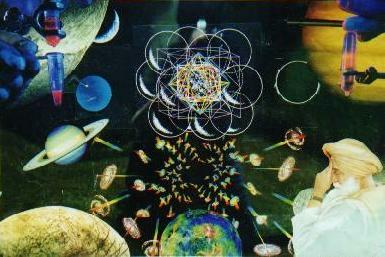
In antiquity, the Pythagoreans, Orphics and Platonists taught that the
soul possessed a kind of radiating subtle body as a vehicle (ochema)
for its manifestation. The Pythagorean life principles served to
free the soul from course matter and make it "bright" (augoeides).
The "brightness" of Plato became the "light soul" in Neoplatonism.
It embidied the idea of the body of light or of a higher immortal subtle
body. This eternal shining vehicle is also called 'star-like.'
This shining soul, this radiant body and the light body of the soul do
not blend abruptly into the coarse material body. There is a body-spirit
between them, which animates the corporeal.
The alchemists and hermeticists held similar ideas and attempted to produce
in their work the transformation and regeneration of the inner spirit of
the subtle body. Islam has the idea of the two-part resurrection
body--the Diamond Body. The essential subtle body is archetypal,
eternal, imperishable, the eternal individuality, the corpus supracoeleste
in man, his transcendental alter ego and the light body. Alchemy
emphasized the continuous element of soul. This work aims at making
a unity of them by incorporating the "layers" which are closer to the body.
Man is a microcosm and possesses a divine and a mortal body. The
mental nature corresponds to the fixed stars, the mind to Saturn, the social
aspect to Jupiter. These are followed by the unreasonable parts,
consisting of passions (Mars), eloquence (Mercury),. desire (Venus), perception
(Sun), and the vegetative aspect (Moon). The radiating soul vehicle
(augoeides ochema) corresponds to the sky. This radiating
soul vehicle consists of the quintessence of the four elements whose form
is spherical. For Aristotle this quinessential body is transparent
and crystal-like--an emanation of the heavenly sphere.
The cosmic aspect of the collective unconscious continues to exist, separated
from the deceased, while there remains with him only that aspect which
has been incarnated in him. Active imagination gives shape to that
which is psychologically objective and true and is the source of all religious
experience, of visions, revelations, true insight. There is a coincidentia
oppositorum, a region where the soul and body meet indistinguishably
in the center. Then this "archetypal earth" is united with the archetype
of the Self, we perceive the union of the unus mundus, the background
of synchronistic events.
In the highest state, the separation of all form is dissolved into absolute
unity and formlessness. Only that part which one has made conscious
is taken along as "fruit," into that Beyond, and depends finally on the
connection of the ego with the infinite or with something divine.
Conscious realization of the Self as spiritus rector of all biological
and psychological occurrences, represents the eventual unity of all archetypes,
a possession which cannot even be lost in death. This is similar
to the sages of India who emphasize the unity of the personal Atman (Self)
and the cosmic Atman.

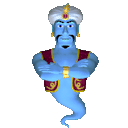





Under Synergetic Construction
File Created: 01/07/2000
Last Updated: 02/02/2000


![]()








![]()






